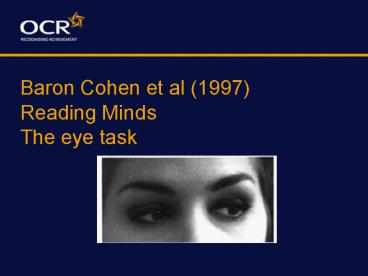Baron Cohen et al (1997) Reading Minds The eye task - PowerPoint PPT Presentation
1 / 25
Title:
Baron Cohen et al (1997) Reading Minds The eye task
Description:
Baron Cohen et al (1997) Reading Minds The eye task Baron Cohen et al (1997) Reading Minds The eye task Baron Cohen et al (1997) Advanced test for theory of mind in ... – PowerPoint PPT presentation
Number of Views:471
Avg rating:3.0/5.0
Title: Baron Cohen et al (1997) Reading Minds The eye task
1
Baron Cohen et al (1997)Reading MindsThe eye
task
2
Baron Cohen et al (1997)Reading MindsThe eye
task
Which word best describes what this person is
thinking or feeling CONCERNED or UNCONCERNED
3
Baron Cohen et al (1997)
- Advanced test for theory of mind in adults with
Autism - Discussion
- Why minds can only ever be a theory!
Are these two people happy or sad?
4
Baron Cohen et al (1997)
- Research Question WHY do adults with autistic
spectrum disorders have problems with social
relationships - The hypothesis
- That adults with Asperger Syndrome (Autism) cant
interpret states of mind from reading eyes
5
Baron Cohen et al (1997)
- Ist order Theory of Mind task
- Reasoning what another person is thinking
(example Sally Ann test) - Normal children develop this ability by the age
of 6 BUT the Sally Ann test is not appropriate
for adults
6
Baron Cohen et al (1997)
- Method Natural experiment
- 3 groups of participants
- IV Normal, Autistic, Tourettes syndrome
- DV performance on eye task (maximum score 25)
7
Baron Cohen et al (1997)
- Participants
- 16 autistic (Asperger) 13 male 3 female
- 50 normal, 25 male, 25 female
- 10 Tourettes patients, 8 male, 2 female
- matched on age normal intelligence
Note The 2 clinical groups had passed 1st order
TOM tests at 6 year old level
8
Baron Cohen et al (1997)
- The eyes task procedure
- 25 photos of eyes
- each 15 x 10cm black and white
- each photo shown for 3 seconds
- forced choice question
- tested individually in quiet room
9
Baron Cohen et al (1997)
Which word best describes what this person is
thinking or feeling serious or playful
10
Baron Cohen et al (1997)
Which word best describes what this person is
thinking or feeling reflective or unreflective
11
Baron Cohen et al (1997)
- Forced choice eye task questions
- examples
- TARGET FOIL
- attraction worried
- friendly hostile
- calm anxious
- The TARGET is the correct answer presented
randomised both left and right
12
Baron Cohen et al (1997)
- How was the eye task created
- Magazine photos selected
- 4 judges generated the target words
- TARGET FOIL
- calm anxious
- The TARGET is the correct answer the FOIL is the
opposite
13
Baron Cohen et al (1997)
- CONTROL in generating targets foils
- (increases eye task VALIDITY)
- eye photos shown to panel of 8 adults who did not
know there was a right or wrong answer there
was 100 agreement with TARGET
14
Baron Cohen et al (1997)
- CONTROL tasks
- (1) Gender Identification all participants asked
to identify the GENDER of each of the 25 eye
photos - (2) Basic emotion task all participants asked to
identify the emotion in full face photos, happy,
sad, angry, afraid, surprise, disgust (Ekman
categories)
15
Baron Cohen et al (1997)
- Findings
16
Baron Cohen et al (1997)
- Are females better at reading minds from eyes
than males ?
17
Baron Cohen et al (1997)
- Were these differences significant (above the
level of chance) ? - At a significance level of p lt 0.0001
Normal and Tourettes better than Autistic - At a significance level of p lt 0.0001 Normal
females better than males
18
Baron Cohen et al (1997)
- Conclusion
- Evidence for subtle mindreading deficits in
intelligent adults on the Autistic spectrum - The eye task is a pure theory of mind test
because there is NO context
19
Baron Cohen et al (1997) Ecological Validity?
- Is the way the experiment measures the DV (Theory
of Mind) - and the experimental setting
- and the sample of participants realistic in a
real life setting? Would the same Ps behave in
the same way in real life? - Discuss why or why not?
20
Baron Cohen et al (1997)Types of datadiscuss
strengths limitations
- Quantitative matters of fact objective,
scientific replicable - useful for analysis comparison
- or
- Qualitative matters of opinion
- subjective, rich in detail, can be hard to
analyse, may be misinterpreted
21
Baron Cohen et al (1997) The experimental
methodology
- Was the method appropriate for the aim?
- Are the experimental conditions realistic
(mundane realism real world realism) - How was the DV operationalised and was this a
valid measure of the behaviour being studied?
22
Baron Cohen et al (1997)The experimental
procedure
- How were the participants allocated to the
conditions and were controls used to remove
extra variables ? - Were there any cues that might have generated
demand characteristics ? - RELIABILITY Could the study be replicated to
find the same results? Why or why not?
23
Baron Cohen et al (1997) The sample
- Who were the participants
- Was the sample biased in any way?
- Was the sample large enough to mask the effect of
individual differences? - To which population can we safely generalise the
findings?
24
Baron Cohen et al (1997)Reading minds from eyes!
Which word best describes what this person is
thinking or feeling sympathetic or unsympathetic
25
(No Transcript)































